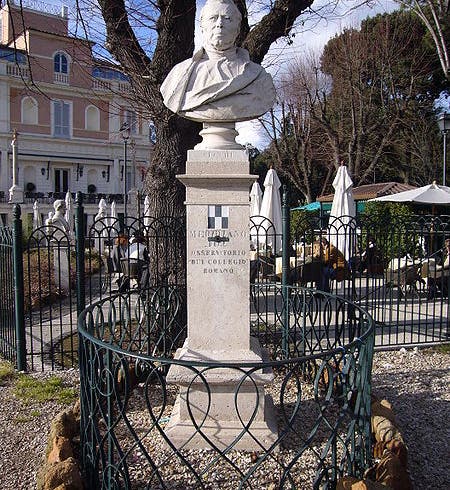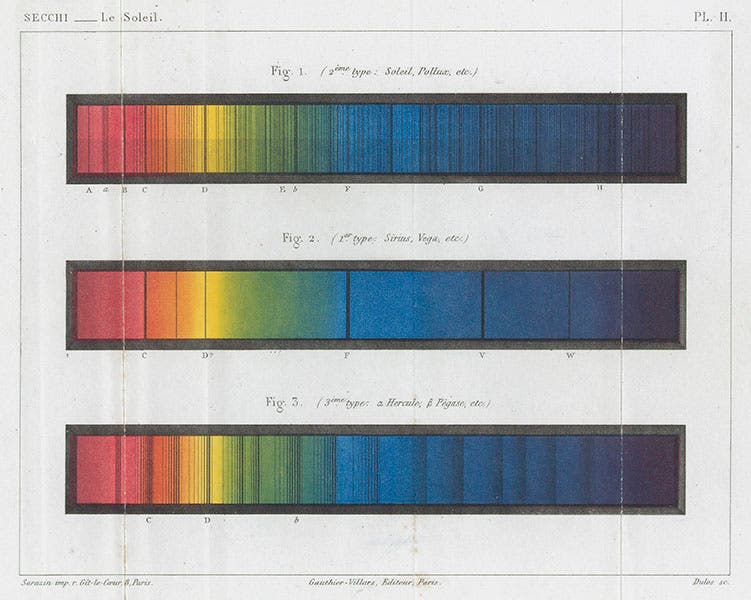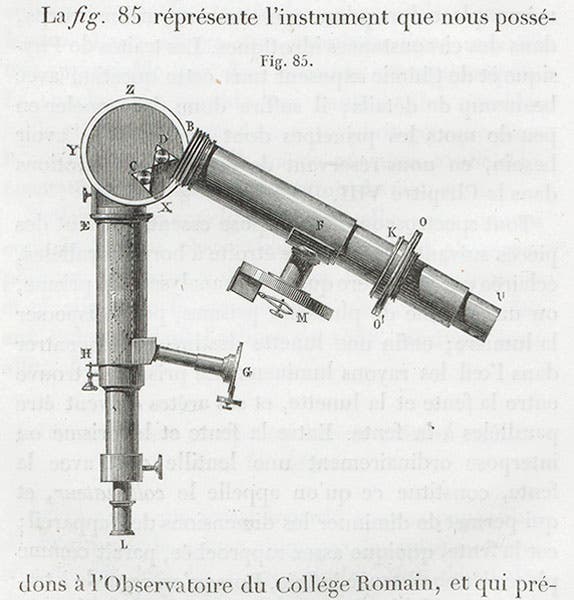Scientist of the Day - Angelo Secchi
Angelo Secchi, an Italian astronomer, was born June 28, 1818. Secchi was a Jesuit and spent most of his life with the Observatory of the Roman College in Rome, serving as its Director from 1850 to 1878. Secchi observed the planets and stars from the roof of the Church of St. Ignatius, which gives the term “study of the heavens” a rich double meaning. Secchi is best known for his spectrographic studies of the Sun and the stars. Spectroscopy as a science began in 1859, when Gustav Kirchhoff and Robert Bunsen in Germany discovered that the dark lines in the spectrum of the Sun are caused by the presence of specific elements in the solar atmosphere, and that one can study the chemistry of the Sun simply by routing a solar beam through a prism. Secchi immediately jumped onto the spectral bandwagon, and he would write a book on spectroscopy and the Sun, published in French as Le Soleil (1870), with several dramatic chromolithographs. We have the first edition in the Library, as well as the second French edition (1875) and the first German edition (1872).
But Secchi’s most innovative idea was to extend spectroscopy to the stars. For their spectrographic studies, most observers, such as William Huggins in England, put the prism at the eye-end of the telescope, since this gave the most dispersion (spread the spectrum out the most), making it easier to identify individual dark or bright lines. But if you try that with the stars, which are millions of times fainter than the sun, then the spectral lines are much too faint to see. So Secchi placed his prism in front of the objective, the lens at the far end of the telescope. The result was that the light from each star in the field of view was spread out a small amount, and while one could not distinguish individual lines in those tiny smudges, one could see enough to realize that not all stellar spectra are alike. Secchi identified four different patterns. There were stars like Sirius, which had only a few dark lines. He called those Type 1. Then there were stars like the Sun, which had hundreds of spectral lines; these constituted Type 2. Type 3 and Type 4 were different yet, being much redder than the white and yellow stars. Two chromolithographs from Le Soleil show these four types, several of them twice (second and third images).
It would turn out that these four groups were not enough, and a team of women at Harvard College Observatory, including Annie Jump Cannon and Antonia Maury, would later replace Secchi’s Types 1-4 with a different system of spectral classification, in which stars are assigned a letter from the sequence: OBAFGKM. But that takes nothing away from Secchi’s pioneering realization, 30 years earlier, that stars differ chemically from one another and can be classified according to their spectral differences.
After Secchi moved the College Observatory to the roof of St. Ignatius in 1852 (utilizing a pier intended for a dome that was never built; fourth image), he apparently erected a pillar a little over a mile away, due north, on the Pincian Hill. The pillar still stands, with an inscription on it that says as much. There is also a hole in the pillar, which the inscription says is for the Meridian of Rome to pass though. Meridians don’t need passage holes, but perhaps Secchi trained the observatory telescope on this hole to determine true north. Today, fittingly, there is a bust of Secchi standing on top of the pillar (first image). There are several hundred busts in the Pincian Garden, but I doubt that any have a history as rich as this one.
Our other images show the telescope (fifth image) and one of the spectroscopes (sixth image) of the Roman College used by Secchi for his spectroscopic studies. Dr. William B. Ashworth, Jr., Consultant for the History of Science, Linda Hall Library and Associate Professor, Department of History, University of Missouri-Kansas City. Comments or corrections are welcome; please direct to ashworthw@umkc.edu.









![Using an astrolabe to measure the depth of a well, woodcut in Elucidatio fabricae vsusq[ue] astrolabii, by Johannes Stöffler, 1513 (Linda Hall Library)](https://assets-us-01.kc-usercontent.com:443/9dd25524-761a-000d-d79f-86a5086d4774/a998eb50-55d2-4a88-ace2-a50aa5fa86e7/Stoffler%201.jpg?w=210&h=210&auto=format&fit=crop)

